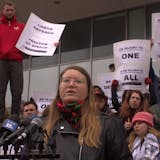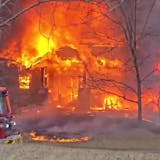When leaders from the Red Lake Band of Chippewa and the city of Minneapolis broke ground Saturday on an affordable housing complex on Cedar Avenue, they were marking a turning point.
Mayor Jacob Frey, who has made affordable housing a signature issue, described the ceremony as a key moment in a complicated story arc. A sense of urgency for the project sprang from a sprawling homeless encampment across Hiawatha Avenue, which then gave way to the city's Navigation Center temporary shelter. That shelter was on the very 1.5-acre site where the new six-floor complex will stand.
Leaders touted the $35.8 million project — named Mino-bimaadiziwin, Ojibwe for "the good life" — as a visionary initiative spearheaded and overseen entirely by the Red Lake tribe, with the city pitching in $4.7 million as well as added support through tax credits and help acquiring the land.
They acknowledged that with 110 units, the new complex will make but a minor dent in a Twin Cities affordable housing shortage that has disproportionately affected American Indian residents.
Still, "this is going to be a place where our people can gather — not only gather but carry on our way of life," said Red Lake Band secretary Sam Strong.
The complex will host a substance-abuse and mental health clinic, addressing issues Frey noted are leading causes of homelessness.
All units will be open to residents and families making below 60% of the area's median income, with a portion reserved for those whose income is at 30% of the median or below, what the city defines as "deeply affordable." Thirty percent of the median is about $28,000 for a family of four, according to the city.
Thirty three-bedroom units are designed to accommodate large families, which face especially steep hurdles in finding affordable housing.


